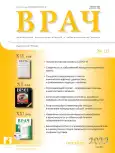IMPACT OF THE COVID-19 PANDEMIC ON THE DEVELOPMENT OF DESYNCHRONOSIS IN MEDICAL STUDENTS AND ITS POSSIBLE CORRECTION
- Authors: Novitsky I.A1,2, Potupchik T.V1, Kupriyanov A.B1, Perevertov T.A1
-
Affiliations:
- Prof. V.F. Voino-Yasenetsky Krasnoyarsk State Medical University, Ministry of Health of Russia
- Research Institute for Medical Problems of the North, Federal Research Center “Krasnoyarsk Research Center, Siberian Branch, Russian Academy of Sciences"
- Issue: Vol 33, No 10 (2022)
- Pages: 74-78
- Section: Articles
- URL: https://journals.eco-vector.com/0236-3054/article/view/114711
- DOI: https://doi.org/10.29296/25877305-2022-10-15
- ID: 114711
Cite item
Abstract
The paper considers the relationship between the degree of desynchronosis in students and the form of their education. A total of 144 students of the Krasnoyarsk State Medical University were surveyed to obtain statistical data. The results were statistically processed by a nonparametric analysis. It is shown that the level of desynchronosis decreases, but the quality of the educational process decreases during distance learning (DL). Attention is drawn to the reduction in physiological and cognitive parameters (the worse quality of sleep and its shorter duration, academic underachievement) in students after leaving distance education for full-time education. The paper gives options for possible correction of the identified disorders
Full Text
About the authors
I. A Novitsky
Prof. V.F. Voino-Yasenetsky Krasnoyarsk State Medical University, Ministry of Health of Russia; Research Institute for Medical Problems of the North, Federal Research Center “Krasnoyarsk Research Center, Siberian Branch, Russian Academy of Sciences"
Email: potupchik_tatyana@mail.ru
MD
Russian Federation,T. V Potupchik
Prof. V.F. Voino-Yasenetsky Krasnoyarsk State Medical University, Ministry of Health of Russia
Email: potupchik_tatyana@mail.ru
Candidate of Medical Sciences
Russian Federation,A. B Kupriyanov
Prof. V.F. Voino-Yasenetsky Krasnoyarsk State Medical University, Ministry of Health of Russia
Email: potupchik_tatyana@mail.ru
Russian Federation,
T. A Perevertov
Prof. V.F. Voino-Yasenetsky Krasnoyarsk State Medical University, Ministry of Health of Russia
Author for correspondence.
Email: potupchik_tatyana@mail.ru
Russian Federation,
References
- Бобок М.Н. Краснюк И.И., Козлова Ж.М. Регуляция биологических ритмов. Современные способы коррекции десинхронозов. Международный научно-исследовательский журнал. 2020; 7-1 (97): 182-8. doi: 10.23670/IRJ.2020.97.7.031
- Бородулина Е.А., Вдоушкина Е.С., Бородулин Б.Е. и др. Преподавание фтизиатрии и дистанционный экзамен в период пандемии COVID-19. Медицинское образование и профессиональное развитие. 2020; 11 (4): 117-24. doi: 10.24411/2220-8453-2020-14009
- Бородулина Е.А., Калинкин А.В., Бородулин Б.Е. и др. Дистанционное образование по фтизиатрии для студентов в период распространения COVID-19. Медицинский альянс. 2021; 9 (2): 89-94. doi: 10.36422/23076348-2021-9-2-89-94
- Будкевич Р.О., Евдокимов И.А., Будкевич Е.В. Теоретические предпосылки управления биоритмами с использованием функциональных продуктов питания. Техника и технология пищевых производств. 2010; 3 (18): 73-6.
- Государственный реестр лекарственных средств [Электронный ресурс]. Режим доступа: https://grls.rosminzdrav.ru/
- Губин Г.Д., Губин Д.Г. Классификация десинхронозов по причинному фактору и механизмам развития. Два принципа хронотерапии десинхроноза. Фундаментальные исследования. 2004; 1: 50.
- Зарубина Е.Г., Грибанов И.А. Роль светового десинхроноза в регуляции пищевого поведения у крыс породы Wistar в эксперименте. Вестник медицинского института "РЕАВИЗ": реабилитация, врач и здоровье. 2020; 1: 54-6.
- Костенко Е.В., Маневич Т.М., Разумов Н.А. Десинхроноз как один из важнейших факторов возникновения и развития цереброваскулярных заболеваний. Лечебное дело. 2013; 2:104-16.
- Краснова М.С., Чеканова А.А., Злобина О.В. Морфофункциональное состояние семенников при экспериментальном десинхронозе. Бюллетень медицинских интернет-конференций. 2019; 9 (5): 207.
- Нежебовская А.С., Рассадина А.В., Пономарева И.А. Основные факторы, определяющие здоровье. Олимпийская идея сегодня: Мат-лы четвертой междунар. научно-практ. конф. Ростов-на-Дону, 18-20 апреля 2014 г. Ростов-на-Дону: Южный Федеральный университет, 2014; с. 404-8.
- Новицкий И.А., Селицкая О.В., Горбачев И.И. Зависимость проявления головной боли напряжения от тяжести Десинхроноза. Научный форум: Медицина, биология и химия: Сб. ст. по мат-лам V междунар. заочной научно-практ. конф., Москва, 22-30 июня 2017 г. М.: Международный центр науки и образования, 2017; с. 26-9.
- Полиданов М.А., Скороход А.А., Бабиченко Н.Е. Влияние светового десинхроноза на агрегацию тромбоцитов. Modern Science. 2020; 8-2: 207-11.
- Потупчик Т.В., Эверт Л.С., Гришкевич Н.Ю. Характеристика социально-психологической адаптации и нервно-психического здоровья студентов разных форм обучения. Сибирское медицинское обозрение. 2019: 4: 54-61. doi: 10.20333/2500136-20194-54-61
- Такоева З.А., Тагаева И.Р., Медоева Н.О. и др. Многолетний анализ результатов хрономониторинга здоровья населения Северной Осетии. Владикавказский медико-биологический вестник. 2011; 12 (19): 32-8.
- Asher G., Schibler U. Crosstalk between components of circadian and metabolic cycles in mammals. Cell Metab. 2011; 13 (2): 125-37. doi: 10.1016/j.cmet.2011.01.006
- Cappadona R., De Giorgi A., Boari B. et al. Nurses, sleep disturbances, desynchronization of circadian rhythms, and performance: a dangerous liaison? A narrative mini-review. Eur Rev Med Pharmacol Sci. 2021; 25 (22): 6924-33. doi: 10.26355/eurrev_202111_27241
- Damiola F., Le Minh N., Preitner N. et al. Restricted feeding uncouples circadian oscillators in peripheral tissues from the central pacemaker in the suprachiasmatic nucleus. Genes Dev. 2000; 14 (23): 2950-61. doi: 10.1101/gad.183500
- Oosterman J.E., Wopereis S., Kalsbeek A. The Circadian Clock, Shift Work, and Tissue-Specific Insulin Resistance. Endocrinology. 2020; 161 (12): bqaa180. doi: 10.1210/endocr/ bqaa180
- Reznick J., Preston E., Wilks D.L. et al. Altered feeding differentially regulates circadian rhythms and energy metabolism in liver and muscle of rats. Biochim Biophys Acta. 2013; 1832 (1): 228-38. doi: 10.1016/j.bbadis.2012.08.010
Supplementary files









